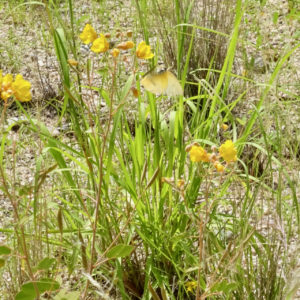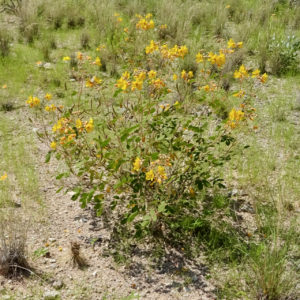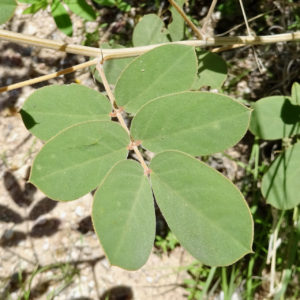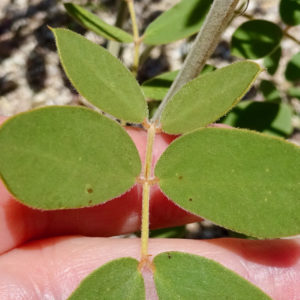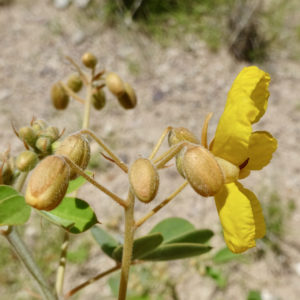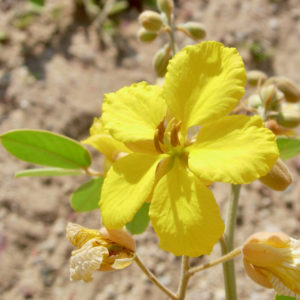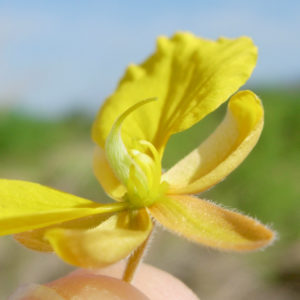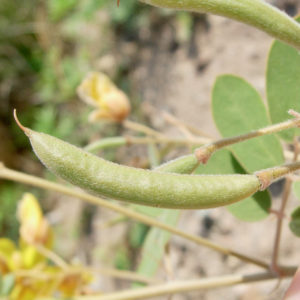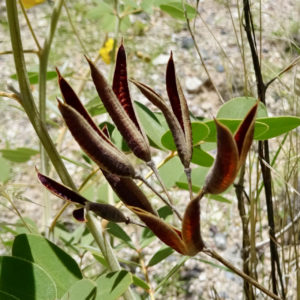Desert Senna
Senna covesii
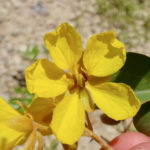
About the Plant
Desert senna is a short-lived perennial with many stems growing from a woody base. The stems often branch, giving the plant the appearance of a shrub. Desert senna can grow to 2 ft x 2 ft. Its large, bright yellow flowers always attract attention and can appear spring through fall, especially after the monsoon rains begin. The light-colored hairs that cover the plant often give the leaves and stems a grey or white appearance next to other plants. Desert senna is native to the desert southwest, found in both the Mojave and Sonoran Deserts and is found throughout Pima County at lower elevations.
Desert senna is usually not available as potted plants at nurseries but seed can be purchased and will germinate over several years. First year plants may flower. The stems die back in winter and the plant may be leafless in drought. The dead stems can be cut off to improve the appearance of the plant but otherwise this native needs little attention from you. In a landscape situation, modest watering during the hottest season can help prolong flowering. It can grow in most soils except those in low spots that tend to become water-logged. Desert senna will spread by seed to other locations in your landscape.
Notes:
- The previous scientific name for this plant was Cassia covesii.
- Desert senna are buzz pollinated, an unusual mechanism that absolutely requires bees. Learn more about buzz pollination here.
Wildlife value:
- Desert senna is the larval host plant of two native sulphur butterflies - sleepy orange and cloudless sulphur. You can see a cloudless sulphur in the photo below
- Quail are reported to eat the seed of desert senna.
More Information
Map of distribution in US (yellow means species is rare)
Technical botanical description from SEINet
In books:
Native Plants for Southwestern Landscapes by Judy Mielke, page 251.
Trees and Shrubs for the Southwest by Mary Irish, page 241.
ID Characteristics
Desert senna is a perennial with a shrubby appearance. Though the stems may die back with drought or winter cold, older plants can be large with many stems, 2 ft x 2 ft.
The leaves of desert senna are alternate and even-pinnate, that is, there are an even number of leaflets, typically 4, 6, or 8 along the leaf stalk. The leaves are 3-4 inches long, 2.5 to 3 inches wide. The opposite leaflets overlap slightly and can be as long as 1.5 inches and about half that wide. The leaflets are often broadest toward the tip and the leaflet tip may have a thin, abrupt point. Two narrow stipules remain attached at the base of the leaf (click photo to enlarge). The leaflets are covered with short, light-colored hairs that give the leaves a whitish, soft appearance.
The leaf of desert senna has several extrafloral nectaries. These are found on the stalk, always between two leaflet. You can see one nectary in the center of the photo, a thin, short, upward protrusion.
The flower clusters arise from a leaf axil and are held on a long stalk, 3-4 inches long, that usually reaches above the associated leaf. There are 4-8 flowers in each cluster, each held on a 1/2 - 3/4 inch stalk. In the photo above, only one flower has opened, the others are still in bud, showing the 5 hairy sepals of each flower. The bud is about 1/4 inch long. In the cluster to the far left of the photo, you can see several long slender bracts that look similar to the stipules seen at the base of the leaves.
The 5 bright yellow petals of desert senna open to become a flower about 1 inch wide. Each petal is clawed, that is, it narrows at the base. There are often darkened veins that arise from the claw and reach to the edge of the petal.
The flower of desert senna has 7 stamen plus 3 that are infertile (staminodes). The pistil is hairy, slightly curved, and narrows to a tip.
The fruit of desert senna grows to about 1 inch long, still retaining the elongated tip. The sepals, petals, and stamen drop off as the fruit grows. The fruit dries to a brown, then opens from the tip down. The inside of the fruit is often corrugated, showing where the dark seeds rested within the pod. Open pods can stay on the plant for several months, even as more flowers open.
